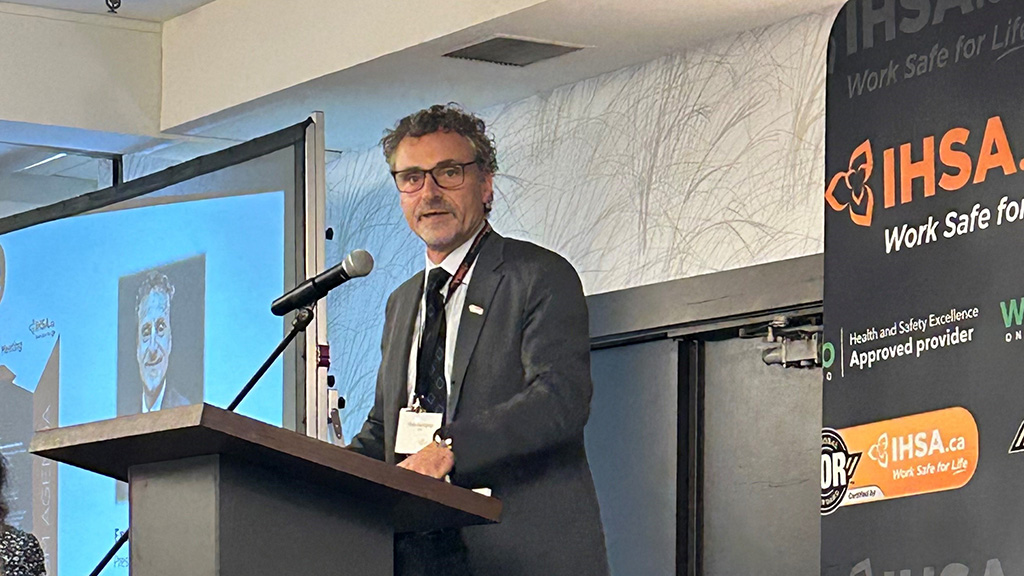If we want to see a change in our world, someone’s got to take action, and if not you, then who?
That was the question Jennifer Khan, vice-president of inclusive diversity at EllisDon and keynote speaker at the Infrastructure Health and Safety Association’s annual general meeting, posed to the crowd.
It was also the question she had to think long and hard about before taking on the EDI role at EllisDon.
“I have a quote on my white board in my office…It says ‘if your heart’s not in it, your head and hands will not be motivated to excel,’” Khan stated.
“It’s something that I picked up while working in training and development…In that role, much like in my current role, and very similar to safety, and everyone in this room, our job is to influence. To be agents of change. To move people into action without any or little direct authority over them. And for that, you need to engage a multi-pronged strategy, one that engages their mind, body and touches their heart.”
She spoke about how safety and inclusive diversity intersect.
“The data clearly tells us that we need to diversify our workforce and create working environments that are safe and inclusive for all, at the very least starting with zero tolerance policy, procedures and gender inclusive PPE,” said Khan.
According to a Canadian �鶹��ý����ion Association 2019 report, one in four people in the construction industry will be 65 years or older by 2027.
“If you think you’re having a hard time now to get people to tie off or wear proper gloves, just think about how hard it will be when they are doing the work of two other people,” said Khan. “The same report suggested that people in underrepresented groups are the key to filling the labour shortage, primarily women and people of colour.”
She said reading hateful and discriminatory graffiti on sites, inappropriate “jokes” and the nooses that have been found on construction sites across North America in recent years are just some examples of why change is needed.
“Whether you’re a foreperson, a project manager, superintendent or an office type like me, we need to have a policy of zero tolerance, a clear reporting process and the openness to have dialogue about discrimination and harassment in tool box talks, team meetings and safety stand downs. Racism and intolerance can happen at any time and any place. We owe it to our people to know that we have their backs, both physically and psychologically,” Khan explained.
While progress has been made, discrimination and harassment will continue to occur, she added.
“While you’re working on this, be prepared that there isn’t a finish line,” said Khan. “There won’t be a day where we can all say, ‘OK, we’re done,’ at least not in our lifetime. So, while we’re doing the work today, you must also prepare for tomorrow and teach and learn from the next generation. Teach them to go beyond tolerance, to empathy and acceptance.”
IHSA highlights from the president
IHSA president Enzo Garritano said although it was disruptive start to the year in 2022, after the first quarter it became a really busy time and an opportunity for the association to provide its services to the industry.
“To say there was an overwhelming demand of our services is an understatement,” said Garritano.
The association’s strategic plan, going into its third year, strongly aligns with the Ministry of Immigration, Training and Skills Development and Chief Prevention Officer Dr. Joel Moody’s Prevention Works strategy.
The IHSA plans to improve services for small businesses. It is also going to continue to increase the awareness of the benefits of health and safety management systems as a provider of COR (Certificate of Recognition), with over 700 COR certified firms.
It will continue to promote the Workplace Safety and Insurance Board’s (WSIB) Safety Excellence Program for the betterment of the workers and businesses.
IHSA is also making strides when it comes to mental health.
“We were the group on behalf of the system to work towards solutions on mental health and opioids in the construction sector,” Garritano explained. “Work has commenced and is underway…It is an area that really we are starting on and I think the whole sector is at the infancy stage.”
In terms of occupational illness, the IHSA is going to continue to work with partners on various items including the silica tool.
Garritano also thanked staff and the management team.
“We train thousands of people,” he explained. “That means were taking thousands of calls and processing thousands of orders and distributing thousands of products. To do so for 60,000 participants is not an easy thing.”
Input is needed from all stakeholders whether they are in the construction, utilities or transportation sectors.
“Without the network and the people, the stakeholders, the input you provide isn’t there and we can’t really get on that improvement plan and prevention activities,” he said. “We have a lot of challenges in regards to the risks that are out there and really need assistance in communicating that out…Without that input it’s hard for us to come up with the right solutions that meet your needs.
“For those who haven’t been involved that long…when you come in the room it’s hard to discern who is labour and who is management because everyone typically takes the hat off and works towards the prevention initiatives,” he added.
Following the meeting the co- chairs of the Labour-Management Network were invited to participate in the Provincial Labour Management Health and Safety Committee + Labour Management Co-Chair Session.
Follow the author on Twitter @DCN_Angela











Recent Comments
comments for this post are closed